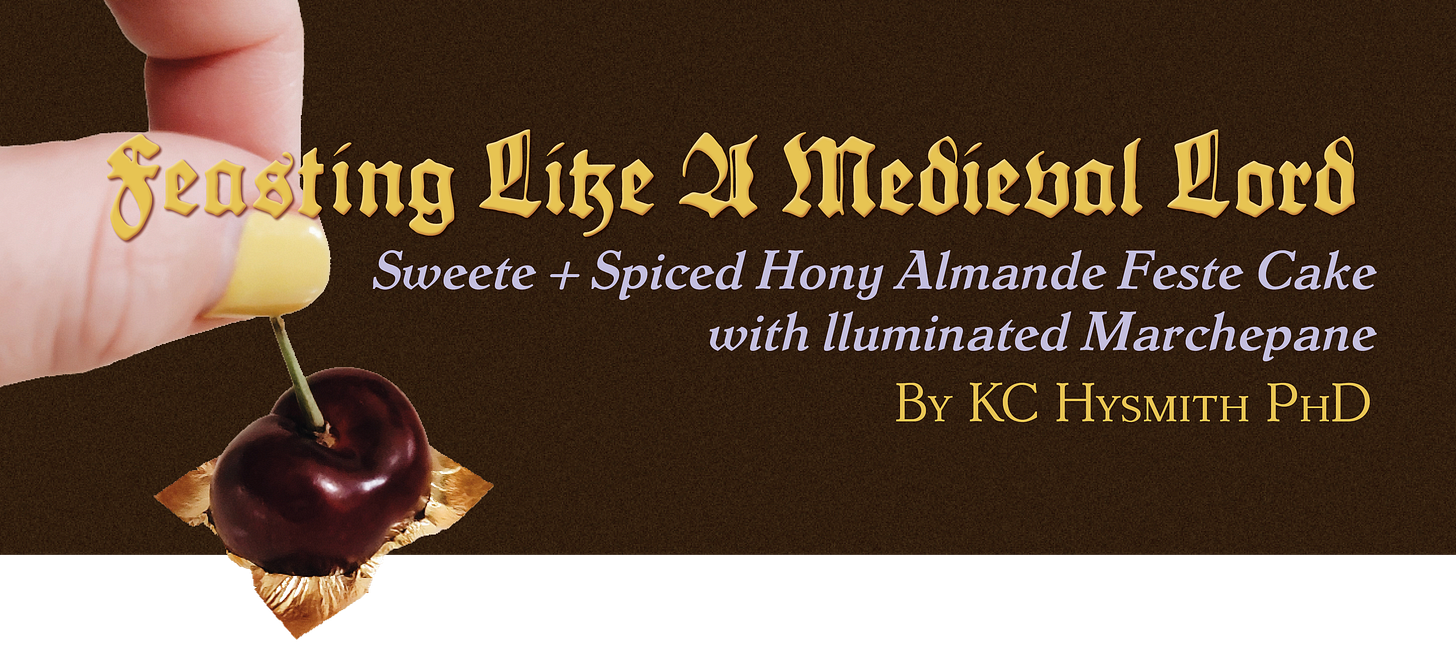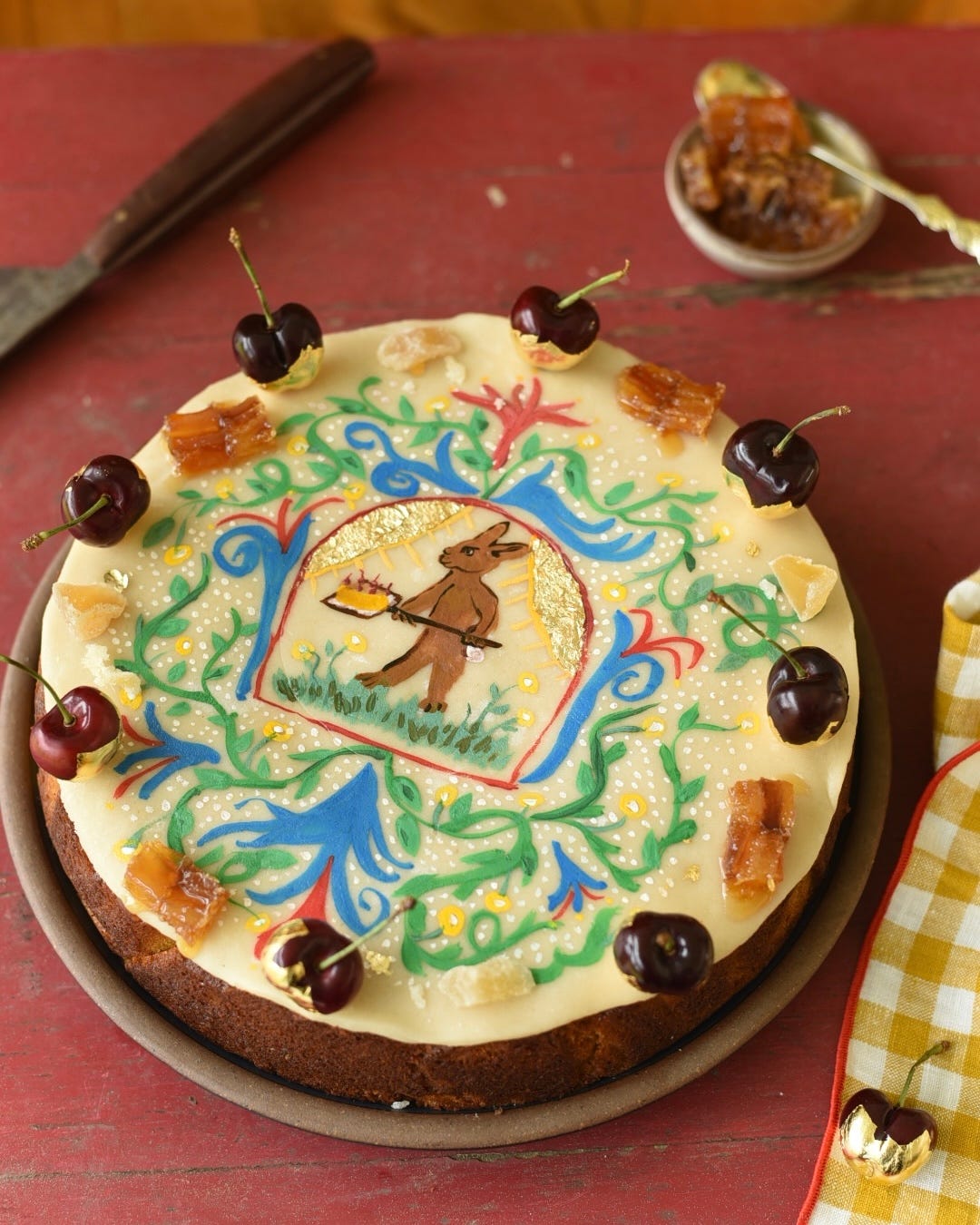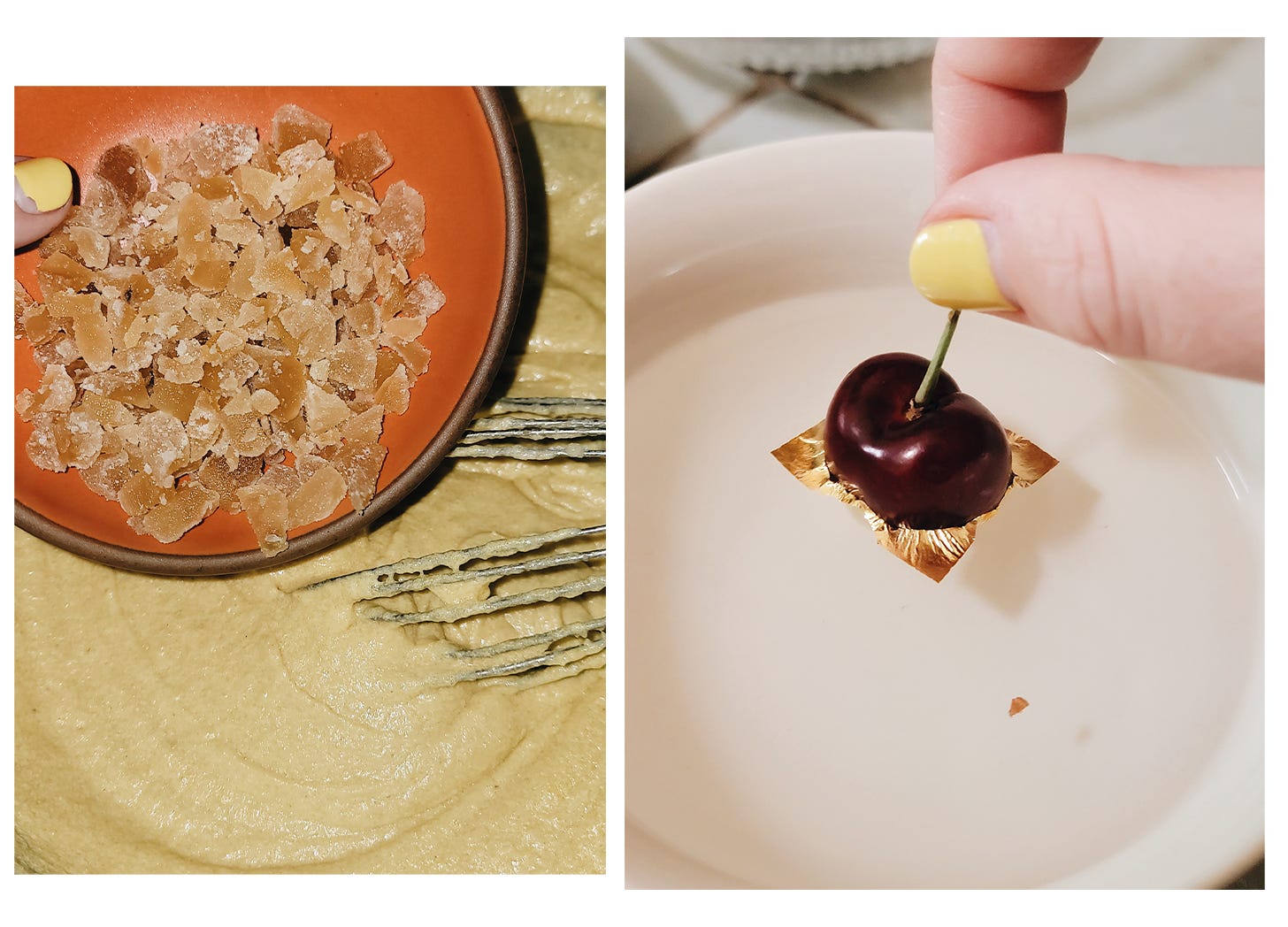Feasting Like A Medieval Lord
KC Hysmith's Sweete + Spiced Honey Almande Feste Cake with Illuminated Marchepane
To celebrate the launch of The Medievalist, our first print issue, we’re publishing a selection of stories from the magazine, plus a few newsletter-only additions, for all of you wenches to enjoy. Today, we give you food scholar and recipe deliver KC Hysmith’s take on a medieval-style cake, adapted for modern-day palettes. The Medievalist is available for purchase online, now!
***P.S. If you're local, go snap a photo of yourself at our Medievalist window display at SoHo News International and post it to Instagram with @mixed.feelings tagged — you'll be automatically entered to win some loot from one of our favorite purveyors: Anmé.***
Spanning over 1000 years, the Medieval Era was marked by numerous wars, trade agreements, and, of course, cakes. Thanks to wildly varying baking technologies, as well as flavor palates, medieval cakes looked and tasted differently from place to place and century to century.
This cake is a sort of “Greatest Hits” of medieval Europe and its broader trading partners, combining flavors that would have been customary on royal feast tables and popular aesthetics of the era. In general, cakes would have been small, personal-sized sweets baked in a wood-fired oven. Yeast was largely reserved for beer and bread, so cakes remained flat and in single layers. Refined white flour, imported spices, and sugar were costly, but were readily available. Honey was still the preferred sweetener across Europe. Other staple cake ingredients of the time period include ground almonds, almond milk, and flower waters. Medieval sumptuary laws — regulations designed to control conspicuous consumption and maintain a strict social hierarchy — meant that enrichments to baked goods and excess decoration were exclusive to the affluent. This Medieval Feast cake has it all: giant proportions (for the era), butter AND eggs, sugar AND honey, spices, and gilded cherries.
Yellow-hued foods were all the rage throughout the Middle Ages, so this cake is tinted with time-period appropriate turmeric powder. Lastly, a sheet of illuminated marzipan rests atop the cake featuring motifs and patterns common to the era, along with my favorite piece of medieval marginalia: a rather grumpy anthropomorphic rabbit baking a cake. Medieval feasts would have been similarly colorful and adorned using edible (and sometimes inedible!) colorings made from plants, herbs, and flowers. Turmeric and saffron were used to make bold yellows, beets and sandalwood for reds, and purple cabbage and mulberries for blues.
Baking notes: This recipe calls for more sugar than most medieval cakes would use, but it’s still less sweet than our modern tastes. The baking powder is anachronistic (chemical leaveners weren’t common until the 18th century), but I promise you, you don’t want to mess around with ale barm.
Sweete + Spiced Honey Almande Feste Cake with Illuminated Marchepane
(sweet and spiced honey almond feast cake with illuminated marzipan)
Serves 10-12
320 g all purpose flour (King Arthur brand would be very apropos)
170 g almond flour
4 teaspoons baking powder
2 teaspoons salt
225 g sugar
200 g honey
2 sticks unsalted butter, softened to room temperature
3 eggs
2 tablespoons elderflower syrup
1 tablespoon ground ginger
1 teaspoon ground nutmeg
1 teaspoon ground turmeric
325 g almond milk
80 g finely chopped candied ginger
10-12 oz marzipan, depending upon thickness desired (store bought is fine)
Powdered sugar (for rolling out marzipan)
Optional: Fresh cherries, honeycomb, edible gold leaf, food coloring
Make the cake
Preheat the oven to 350°. Grease a 10-inch cake pan and line with parchment paper.
In a large bowl, whisk together the flours, baking powder, and salt.
In a second bowl, cream the sugar, honey, and butter until fluffy. Stir to incorporate the eggs, elderflower syrup, and spices.
Alternate adding a third of the flour and a third of the milk into the butter mixture until combined. Fold in the candied ginger.
Pour the mixture into the pan. Bake on the middle rack of the oven. After 30 minutes, lower the temperature to 325 degrees. Bake for another 40 minutes or until a toothpick comes out clean. (Tip: If the top begins to brown too quickly, carefully tent a piece of foil over the cake.) Allow the cake to cool completely in the pan.
Prepare the marzipan
Sprinkle a large piece of parchment paper and a rolling pin with powdered sugar. Roll out the marzipan into a thin sheet. Use the bottom of the cooled cake pan and trace with a sharp knife to create a circle, peeling away excess. Flip the parchment marzipan-side down on top of the cake.
Gild the cherries
Fill a bowl with room temperature water and gently place a piece of gold leaf on the surface. Hold a cherry by the stem and push into the middle of the gold leaf while twisting. When the gold sheet is almost fully submerged, swirl the cherry to remove excess gold leaf and seal the sheet to the cherry before setting aside.
To assemble
Use food dyes (gel is best, thinned with some water) and leftover gold leaf to paint your favorite imagery on top. Arrange the cherries, honeycomb, and candied ginger around the edges of the cake.
KC Hysmith, PhD, is a food scholar and writer who focuses on the intersections of food history, gender, and digital media. She has written for The Washington Post, Cake Zine, Saveur, Food52, Gastronomica, and Eater, and is the co-author and co-editor of several books on food and culture, including An American Girl Anthology. See more of her work at kchysmith.com and at @kchysmith on Instagram.









